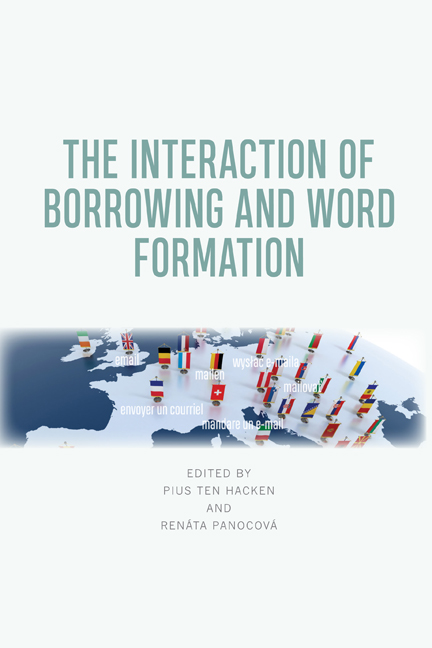Book contents
- Frontmatter
- Contents
- List of Figures and Tables
- List of Contributors
- Preface
- List of ISO-639 Language Codes
- Introduction
- 1 Word Formation, Borrowing and their Interaction
- Part I Compounding
- 2 Compounding and Contact
- 3 Neoclassical Compounds between Borrowing and Word Formation
- 4 Borrowed Compounds, Borrowed Compounding – Portuguese Data
- 5 Compound Calques in an Eighteenth-Century German-Lithuanian Dictionary
- 6 (Pseudo-)Anglicisms as Nominal Compounds in Italian
- Part II Affixation
- 7 The Role of Borrowing in the Derivation of Passive Potential Adjectives in Polish
- 8 How an ‘Italian’ Suffix Became Productive in Germanic Languages
- 9 The Suffixes -ismus and -ita in Nouns in Czech
- 10 The Interaction between Borrowing and Word Formation: Evidence from Modern Greek Prefixes
- Part III Naming in Minority Languages
- 11 Loanword Formation in Minority Languages: Lexical Strata in Titsch and Töitschu
- 12 Examining the Integration of Borrowed Nouns in Immigrant Speech: The Case of Canadian Greek
- 13 Interaction among Borrowing, Inflection and Word Formation in Polish Medieval Latin
- Conclusion
- 14 Trends in the Interaction between Borrowing and Word Formation
- Author Index
- Subject Index
1 - Word Formation, Borrowing and their Interaction
Published online by Cambridge University Press: 22 September 2020
- Frontmatter
- Contents
- List of Figures and Tables
- List of Contributors
- Preface
- List of ISO-639 Language Codes
- Introduction
- 1 Word Formation, Borrowing and their Interaction
- Part I Compounding
- 2 Compounding and Contact
- 3 Neoclassical Compounds between Borrowing and Word Formation
- 4 Borrowed Compounds, Borrowed Compounding – Portuguese Data
- 5 Compound Calques in an Eighteenth-Century German-Lithuanian Dictionary
- 6 (Pseudo-)Anglicisms as Nominal Compounds in Italian
- Part II Affixation
- 7 The Role of Borrowing in the Derivation of Passive Potential Adjectives in Polish
- 8 How an ‘Italian’ Suffix Became Productive in Germanic Languages
- 9 The Suffixes -ismus and -ita in Nouns in Czech
- 10 The Interaction between Borrowing and Word Formation: Evidence from Modern Greek Prefixes
- Part III Naming in Minority Languages
- 11 Loanword Formation in Minority Languages: Lexical Strata in Titsch and Töitschu
- 12 Examining the Integration of Borrowed Nouns in Immigrant Speech: The Case of Canadian Greek
- 13 Interaction among Borrowing, Inflection and Word Formation in Polish Medieval Latin
- Conclusion
- 14 Trends in the Interaction between Borrowing and Word Formation
- Author Index
- Subject Index
Summary
The interaction between word formation and borrowing is not a topic that has been studied widely. A likely reason for this is that word formation and borrowing have been studied from different theoretical perspectives. Whereas word formation is usually considered a domain of morphology, borrowing is a phenomenon that has been studied in lexicography, where it has connections with etymology, language policy and contact linguistics. Therefore, we will first present these two perspectives in sections 1 and 2, before considering the possible types of interaction in section 3. This provides a background for the case studies collected in this volume. A common aspect of all case studies is the work with data. Section 4 addresses some general issues that arise in the collection and interpretation of data. Finally, section 5 introduces the chapters against this background.
The morphological perspective
Morphology is the part of the theory of language which is concerned with the internal structure and the formation of words. How exactly the study of words is conceived of depends on the theory adopted. Morphology is usually divided into three main domains: inflection, derivation, and compounding. It is distinguished from syntax, which is concerned with the combination of words into sentences. Which of these divisions is theoretically relevant is a question that is answered differently in different theories. A good example of these decisions is the choice between two primary divisions of the morphological domain, as illustrated in Figure 1.1.
In model A of Figure 1.1, word formation does not appear as a theoretical domain. This is the model adopted, for instance, by Selkirk (1982). In word-based approaches, e.g. Aronoff (1976) and Anderson (1992), model B is adopted. Here the idea is that word formation is a rule component in the lexicon and that lexemes are the input to word formation rules. However, Aronoff (1976) only discusses derivation, and for Anderson (1992) compounding is somewhat of an embarrassment in the sense that the resulting words have an internal structure.
In the Slavic linguistic tradition based on the structuralist and functionalist theoretical framework of the Prague School of Linguistics, word formation is basically understood as a part of lexicology tightly linked with the morphological and lexical levels of language (Dokulil 1994: 127).
- Type
- Chapter
- Information
- The Interaction of Borrowing and Word Formation , pp. 3 - 14Publisher: Edinburgh University PressPrint publication year: 2020



